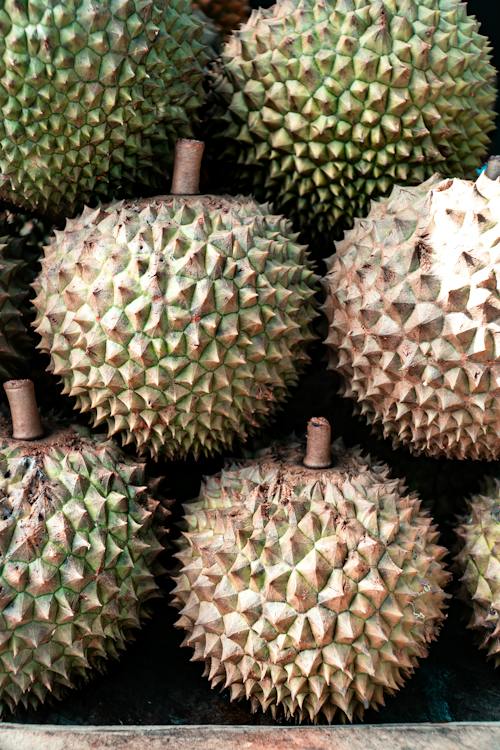“The King of Fruits,” as some regions call it, Durian is several tree species belonging to the genus Durio. There are at least 9 of the 30 recognized Durio species, produce edible fruit. The tree is native to Southeast Asia, which has more than 300 named varieties in Thailand, and 100 in Malaysia, as of 1987. However, there is only one species available in the international market, and it is Duriozibethinus. Other species are sold in their local regions. It is native to Borneo and Sumatra.
A few of the distinctive features of Durian are its large size, pungent odor, and thorn-covered rind. The fruit, which has a similar appearance to jackfruit, can grow as large as 30 centimeters (12 inches) long and 15 cm (6 in) in diameter. The fruit’s usual weight ranges from 1 to 3 kilograms (2 to 7 pounds) has shape either oblong to round, husk green to brown. The fruit has pale yellow to red color, depending on the species.
Some people do not like the fruit’s fragrance, whereas others find the aroma overpowering the unpleasant odor. There are various reactions from the smell, from deep appreciation to intense disgust. Others have described the smell as rotten onions, turpentine, and raw sewage. The odor, which lasts for an extended period up for a few days, has led to the fruit’s banishment from certain hotels and public transportation in Southeast Asia.
By contrast, Alfred Russel Wallace, the nineteenth-century British naturalist, has described its flesh as “a rich custard highly flavored with almonds.” The flesh can be eaten at the different stages of ripeness. Also, used as a flavoring to savory and sweet desserts in Southeast Asian cuisines.
According to healthline.com, a cup (243 grams) of durian pulp provides:
Calories: 357
Fat: 13 grams
Carbs: 66 grams
Fiber: 9 grams
Protein: 4 grams
Vitamin C: 80% of the Daily Value (DV)
Thiamine: 61% of the DV
Manganese: 39% of the DV
Vitamin B6: 38% of the DV
Potassium: 30% of the DV
Riboflavin: 29% of the DV
Copper: 25% of the DV
Folate: 22% of the DV
Magnesium: 18% of the DV
Niacin: 13% of the DV
BENEFITS OF EATING DURIAN
Instant Energizer
Durian fruit has high carbohydrate content, which quickly replenishes low energy levels (in healthy individuals). Enough consumption can aid in fatigue and relieve mental stress and anxiety as it contains a high amount of potassium.
Reduces cancer risk
Containing antioxidants, Durian can help neutralize cancer-promoting free radicals. In one test-tube study, results yielded to the fruit’s potentials to prevent the spread of a strain of breast cancer cells.
Prevents heart disease
Contrary to the belief of many people, Durian does not contribute to the increase in cholesterol levels. Still, it reduces cholesterol levels, the risk of atherosclerosis, or the hardening of the arteries.
Fights infection
The rind of the fruit has antibacterial compounds and anti-yeast properties. Any too much is always not good, but what’s good about eating Durian is that it has a lower glycemic index (GI) than other tropical fruits, so it may spike blood sugar levels less.
GROWING A DURIAN TREE
Flat to steep terrain is favorable for good durian cultivation. In Thailand, many durian plantations are on relatively flat land. In contrast, on Penang’s island, known for growing the finest connoisseur durians in Malaysia, almost all durian farms are on tall hillsides and valley sides, which are fairly steep. One main reason why it’s best to grow the tree in sloping situations because its root system is very sensitive to standing water, and good drainage is therefore essential.
Soil Requirements
Grow your Durian tree in a deep, well-drained sandy clay or a clay loam (deep alluvial or loamy soil). Ensure that the soil is high in organic matter and with a pH range of 6 – 7. Heavy clay soils do not support good durian tree growth and health, as they do not drain well. Seedlings make more vigorous growth when potted into a light and sandy media rather than high in clay content.
Preparation of the Holes
Dig holes with approximately 30 cm wide and 30 cm deep. Deeper holes are recommended when using heavy soil type. Position the seedling into the hole and make sure that the ball of the soil is not broken. Trim spiraled roots to boost root branching. Make sure to plant the seedlings in their dormancy. Cover the hole with soil and press gently to firm the surrounding soil of the seedling.
Spacing
In orchards, the trees are spaced about 6-16 m [20 to 50 feet] apart, aiming for about 156 trees/hectare [64 trees/acre] to 40 trees/hectare [16 trees/acre]. Thinning will be necessary at closer spacings when the trees are 8 to 10 years old to reduce tree density and give remaining trees room for further growth.
Maintenance for taking care of the plants includes regular and proper watering, especially during the dry season, applying fertilizer, mulching, weeding, irrigation, pollination, fruit-thinning, and harvesting.
Durian in Foods
There are so many recipes you can make with Durian. There are durian candies, cakes, bread, ice cream, soup, gelato, crepe, and many more.
In some countries, they have buildings with architectural designs inspired by the fruit. In Singapore, there is Singapore’s esplanade building nicknamed “Durian” as it has spiky dome-shape roofing that looks like Durian. While in Kuala Lumpur, Malaysia, Pusat Sains Negara also appears like the fruit.

